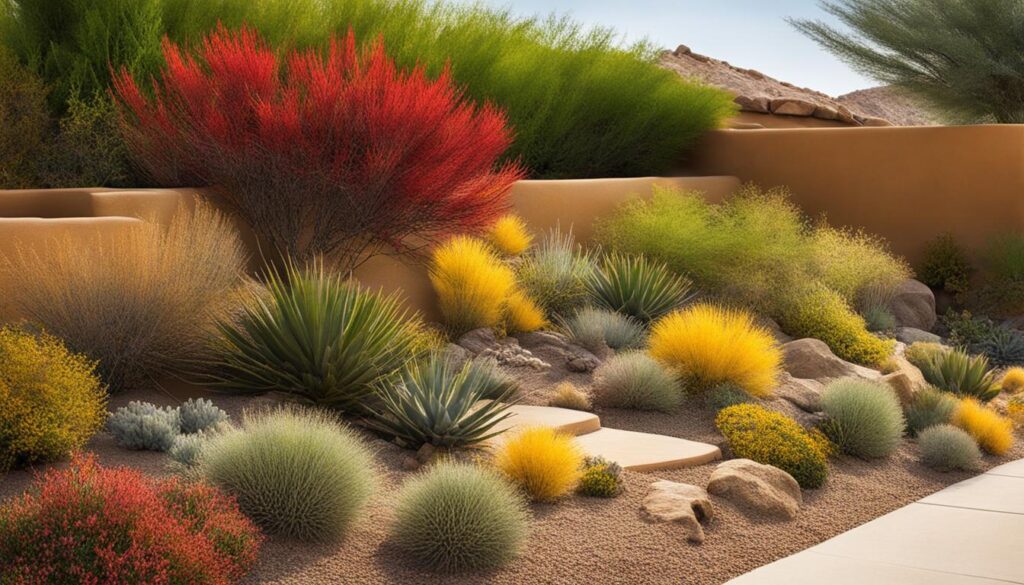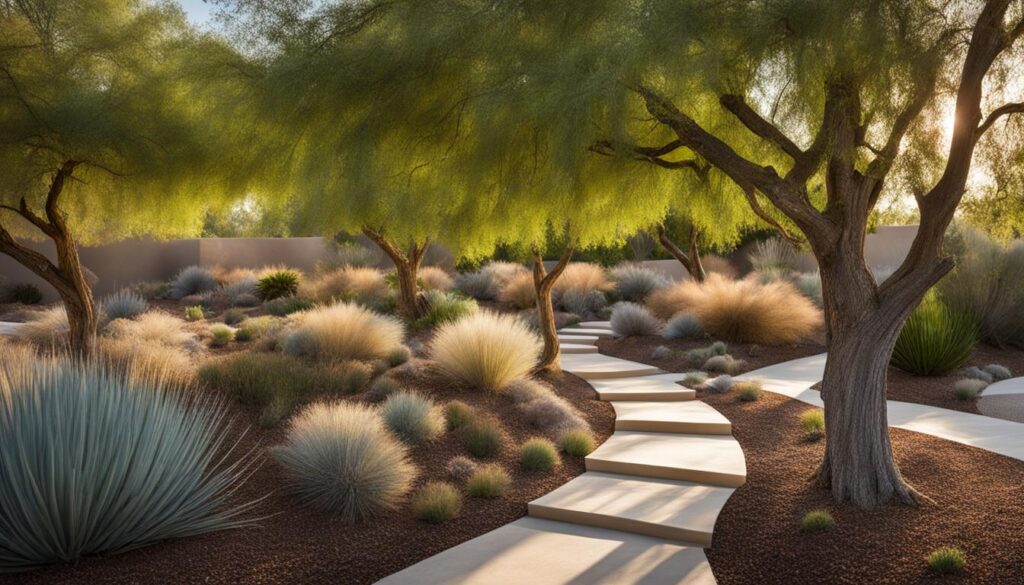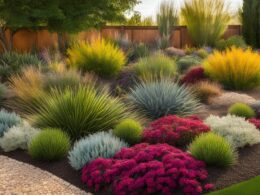Xeriscape is a low-water gardening technique that aims to reduce irrigation needs through the use of drought-tolerant plants. The misconception that xeriscape gardens are barren and dry is far from the truth. In fact, there is a wide variety of plants that work well in xeriscaping, ranging from succulents to flowering plants and even trees. By selecting plants with lower water needs and following xeriscape principles, you can create a sustainable and visually appealing landscape while reducing water bills. Planning in advance, limiting turfgrass, grouping plants with similar water needs, using targeted irrigation systems, mulching, and maintaining/pruning plants are important principles to follow when incorporating xeriscape plants into your garden.
Key Takeaways:
- Xeriscape gardening is a technique that reduces irrigation needs through the use of drought-tolerant plants.
- There is a wide variety of plants suitable for xeriscaping, including succulents, flowering plants, and trees.
- Planning in advance, grouping plants with similar water needs, and using targeted irrigation systems are important xeriscape principles.
- Xeriscape landscaping can help reduce water bills and create a sustainable and visually appealing garden.
- Mulching and maintaining/pruning plants are key practices in xeriscape maintenance.
Benefits of Xeriscape Gardening
Xeriscape gardening offers numerous benefits, with the primary advantage being water conservation. By using plants that require less water, xeriscaping helps to reduce overall water usage in landscaping. This is especially important in areas with water scarcity or drought conditions.
Additionally, xeriscape gardens are more sustainable and environmentally friendly, as they rely less on irrigation and potentially harmful chemicals. By reducing water usage, xeriscaping also results in lower water bills, making it a cost-effective landscaping option in the long run.
By embracing xeriscape gardening, you not only contribute to water conservation efforts but also create a visually appealing and low-maintenance landscape. With the right selection of drought-tolerant plants and the practice of xeriscape principles, you can enjoy the benefits of sustainable landscaping while reducing your water bills.
Key Benefits of Xeriscape Gardening:
- Water conservation: By using plants that require less water, xeriscaping helps to reduce overall water usage in landscaping.
- Sustainable landscaping: Xeriscape gardens rely less on irrigation and potentially harmful chemicals, making them more environmentally friendly.
- Reduced water bills: By reducing water usage, xeriscaping results in lower water bills, making it a cost-effective landscaping option in the long run.
Ground Covers and Fairy Gardens for Xeriscape Maintenance
When it comes to xeriscape maintenance, ground covers and fairy gardens are two excellent options to consider. These low-growing plants not only cover large areas but also add visual impact to your landscape. Incorporating them into your xeriscape garden can create a stunning and sustainable outdoor space.
Some recommended xeriscape ground covers include Sedum rubrotinctum, Pachysandra procumbens, and Ophiopogon japonicus. These plants are not only drought-tolerant but also require minimal water, making them perfect for xeriscape gardens. Their small size and unique characteristics also make them ideal for fairy gardens, which can be placed at the front of garden beds or used as alternatives to traditional lawns.
“Ground covers are a fantastic way to add texture and color to your xeriscape garden. They not only help conserve water but also suppress weed growth and provide erosion control. Plus, they require less maintenance compared to traditional lawns.”
Benefits of Ground Covers and Fairy Gardens:
- Add visual interest and beauty to your xeriscape garden
- Require minimal water and are drought-tolerant
- Help suppress weed growth and provide erosion control
- Low-maintenance compared to traditional lawns
By incorporating ground covers and fairy gardens into your xeriscape maintenance plan, you can enjoy a lush and visually appealing landscape that thrives with minimal water requirements. These plants not only conserve water but also add unique charm to your outdoor space.
Succulents for Xeriscape Maintenance
Succulents are an excellent choice for xeriscape maintenance. These low-water plants are not only drought-tolerant but also add a unique and striking aesthetic to your landscape. Their ability to store water in their leaves and stems allows them to thrive in arid conditions with minimal watering requirements.
There is a wide variety of succulents that are well-suited for xeriscape gardens. Aloe aristata, commonly known as Torch Plant, features fleshy, toothed leaves that add texture and visual interest. Sedum kamtschaticum, also known as Russian Stonecrop, forms a dense mat of small, star-shaped flowers that bloom in vibrant yellow. Euphorbia myrsinites, or Myrtle Spurge, offers blue-gray foliage and chartreuse flowers, creating a striking contrast in your garden.
Whether used as ground covers, in containers, or as focal points, succulents are an ideal choice for xeriscape maintenance. Their low-water requirements and ability to withstand harsh conditions make them a sustainable and visually appealing addition to your landscape.
Shrubs for Xeriscape Maintenance
When it comes to xeriscape gardening, shrubs are an excellent choice for a low-maintenance landscape that conserves water. These plants not only provide structure and privacy but also add visual appeal to your xeriscape garden. By selecting drought-tolerant shrubs and following water-wise landscaping techniques, you can create a thriving and sustainable outdoor space that requires minimal irrigation.
One popular xeriscape shrub is Erigeron karvinskianus, commonly known as Santa Barbara daisy. This perennial shrub features delicate white and pink flowers that bloom profusely, adding a touch of charm to your garden. It requires very little water once established and can tolerate a range of soil conditions.
Another great choice is Juniperus conferta, also known as shore juniper. This low-growing shrub is a hardy and drought-tolerant plant that thrives in sandy soil and coastal areas. Its attractive blue-green foliage provides year-round interest to your xeriscape garden while requiring minimal maintenance.
If you’re looking for a shrub that adds a splash of color to your landscape, consider Callirhoe involucrata, commonly known as winecups or purple poppy mallow. This hardy perennial shrub produces beautiful wine-red flowers that attract butterflies and hummingbirds. It is highly adaptable, tolerating both dry and rocky soil conditions.
Benefits of Xeriscape Shrubs
- Low-maintenance: Xeriscape shrubs require minimal care and pruning, saving you time and effort in maintaining your garden.
- Drought-tolerant: These shrubs have adapted to survive in arid conditions, meaning they can thrive with less water.
- Water-wise landscaping: By using xeriscape shrubs, you contribute to water conservation efforts and reduce your overall water usage.
- Visual appeal: With their varied colors, textures, and foliage, xeriscape shrubs add beauty and interest to your landscape.
By incorporating drought-tolerant shrubs into your xeriscape garden, you can enjoy a vibrant and sustainable outdoor space that requires minimal watering. These low-maintenance plants not only conserve water but also enhance the visual appeal of your landscape. With a variety of shrub options available, you can create a xeriscape garden that suits your preferences and effectively addresses water-wise landscaping principles.
Ornamental Grasses for Xeriscape Maintenance
When it comes to xeriscape maintenance, ornamental grasses are a fantastic choice. These grasses not only add texture and movement to your garden but are also well-adapted to dry conditions, making them drought-tolerant and low-maintenance. Incorporating ornamental grasses into your xeriscape garden can create a visually stunning landscape that thrives with minimal water requirements.
One popular choice for xeriscape gardens is Ophiopogon planiscapus, also known as Black Mondo Grass. This grass features dark, almost black foliage that contrasts beautifully with other plants in your garden. It is a versatile grass that can be used as accents, borders, or even groundcovers.
Karl Foerster Reed Grass (Calamagrostis x acutiflora ‘Karl Foerster’) is another excellent option for xeriscape maintenance. With its upright growth habit and feathery plumes, this grass adds vertical interest and creates a sense of movement in your garden. It’s also a great choice for erosion control on slopes.
If you’re looking to add height to your xeriscape garden, Maiden Grass (Miscanthus sinensis) is a fantastic choice. This grass can reach heights of up to 6 feet and provides a stunning focal point. It offers beautiful foliage that turns golden in the fall, adding warmth and color to your landscape.
Benefits of Ornamental Grasses in Xeriscape Gardens:
- Require minimal water once established
- Drought-tolerant and low-maintenance
- Add texture, movement, and architectural interest to the landscape
- Offer a variety of heights, colors, and foliage types
- Attract wildlife, such as birds and butterflies
“Ornamental grasses are a perfect addition to xeriscape gardens. Their ability to thrive with minimal water and their unique textures and colors make them a standout feature in any landscape.”
By incorporating ornamental grasses into your xeriscape garden, you can create a beautiful and sustainable landscape that requires less water and maintenance. These grasses provide visual interest, texture, and movement while thriving in arid conditions. Whether used as accents, borders, or focal points, ornamental grasses are an excellent choice for xeriscape maintenance.
Can I Use Different Plants for Xeriscape Maintenance If I Need to Replace Them?
If you need xeriscape plant replacement suggestions, consider native drought-tolerant options like yarrow, lavender, or ornamental grasses. These plants can thrive in low-water conditions and are great choices for xeriscape gardens. When considering replacing plants, be sure to choose varieties that are well-suited for the specific climate and soil conditions.
Trees for Xeriscape Maintenance
Trees play a crucial role in xeriscape maintenance, providing shade, privacy, and visual interest to your garden. When choosing trees for your xeriscape landscape, it’s important to select species that are well-suited to dry conditions and have lower water needs. This not only helps to conserve water but also promotes sustainable landscaping practices.
One excellent choice for xeriscape trees is Juniperus virginiana, also known as Eastern Red Cedar. This tree is drought-tolerant and can adapt to various soil conditions, making it a versatile option. Juniperus virginiana also provides year-round greenery and can be used as a windbreak or privacy screen.
Another suitable tree for xeriscape maintenance is Platanus x acerifolia, commonly known as London Plane Tree. This tree has the ability to withstand urban environments and exhibits excellent tolerance to drought. Its large, attractive leaves provide ample shade, and its distinctive bark adds visual interest to your landscape.
Origanum vulgare, also known as Common Oregano or Wild Marjoram, is a compact, drought-tolerant tree that thrives in xeriscape gardens. It offers aromatic leaves, beautiful pink flowers, and attracts pollinators to your garden. This tree is not only low-maintenance but also adds a touch of culinary usefulness to your outdoor space.
Conclusion
Embrace the beauty of xeriscape landscaping and discover the benefits of sustainable gardening. By selecting water-wise plants and following xeriscape principles, you can create a stunning and environmentally friendly garden that thrives in even the driest climates. Xeriscape maintenance not only conserves water but also reduces water bills and promotes sustainable gardening practices.
With a wide variety of xeriscape ground covers, succulents, shrubs, ornamental grasses, and trees to choose from, you can design a visually appealing landscape that requires minimal irrigation. By planning in advance and grouping plants with similar water needs, you can further optimize water usage in your garden.
So, why wait? Take a step towards sustainable gardening and transform your outdoor space with xeriscape landscaping. Create a lush oasis that conserves water, supports the environment, and enhances the beauty of your home. Start incorporating water-wise plants and xeriscape principles today, and enjoy the benefits for years to come.














